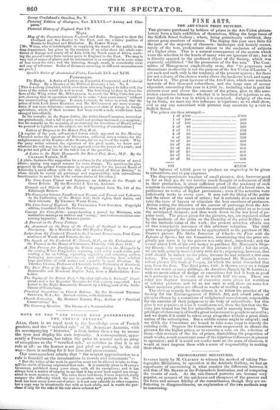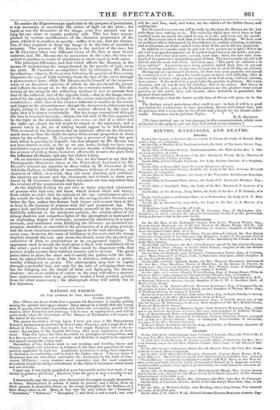PHOTOGRAPHIC MINIATURES.
INVITED lately by M. CLAUDET to witness his method of taking Pho- tographic Miniatures, in operation at the Adelaide Gallery, we had an opportunity of ascertaining in what consists the difference between it and that of Mr. BEARD at the Polytechnic Institution, and of comparing the results of each. As the sun-limned portraits are become very popular, on account of the quickness and cheapness of the process and the force and minute fidelity of the resemblances, though they are un- flattering to disagreeableness, an explanation of the two methods may be interesting. To render the Daguerreotype applicable to the purpose of portraiture, it was necessary to accelerate the action of light on the plate ; for rapid as was the formation of the image, even five minutes was too long for any sitter to remain perfectly still. This has been accom- plished by various modifications of the chemical preparation of the plate, which it is needless to specify : suffice it to say, that the diminu- tion of time required to form the image is in the ratio of seconds to minutes. The process of Mr. BEARD is the quicker of the two ; but as M. CLAUDET takes two different views of the face at once in two cameras, and Mr. BEARD two in succession in the same, the time re- quired to produce a couple of miniatures is about equal in both cases. The principal difference, and that which affects the likeness, is the means of transmitting the image formed by the pencils of light on to the plate. M. CLAUDET accomplishes this by refraction, Mr. BEARD by reflection,—that is, M. CLAUDET, following the practice of Deo UERAE, transmits the rays of light radiating from the face of the sitter through a piano-convex lens ; while Mr. BEARD avails himself of the improve- ment of an American optician, of which he has purchased the patent, and reflects the image on to the plate by a concave mirror. The dis- tortion of the image in the refracting medium is less in amount than that of the reflector, and of the opposite kind,—that is, the image trans- mitted by the convex lens is larger in the centre and smaller at the cir- cumference ; while that of the concave reflector is smaller in the centre and larger at the cittumference : though the deviation in either case is so slight, owing to the smallness of the surface affected by the rays of light, that it is almost incalculable. But the image transmitted through the lens is reversed laterally,—that is, the left side of the face appears to be the right in the miniature, and vice versa ; so that if a sitter had the right eye closed the left would be closed in the miniature, and a person taken in the act of writing would appear to be left-handed. This reversal of the lineaments has an injurious effect on the likeness ; much more so than the slight deviation from actual proportion in those taken by the reflector. M. CLAUDET has a process of fixing the por- trait which is peculiar to himself; but that adopted by Mr. BEARD has not been known to fail, as far as we can learn, though we have seen miniatures exposed to the light for several months without changing: the process of gilding them, however, effectually secures the plate from the influence of climate, and any but violent injury. On an attentive comparison of the two, we are bound to say that the Photographic Miniatures taken at the Polytechnic Institution by Mr. BEARD'S process are superior to those taken by M. CLAUDET at the Adelaide Gallery, in fidelity of resemblance, delicacy of marking, and clearness of effect ; in a word, they are more pleasing and artistical : the shadows are denser and the lineaments less defined in those pro- duced by M. CLAUDET; though these objections are less important than the reversal of the countenance and figure.
At the Adelaide Gallery we saw two or three cancelled miniatures of persons who had very red faces, which looked black and heavy ; from which we infer that the redness of the lips contributes to give to the mouth the dark tint that, added to the strong shadow between and below the lips, makes this feature look larger and coarser than in life, at least in the instance of persons with full and prominent lips. The grave look and formal attitude commonly assumed by the sitters, being faithfully reflected in the miniature portrait, the sombre effect of the strong shadows and colourless lights of the photograph is increased to an unpleasing degree of sternness, occasionally amounting to a repul- siveness, and sometimes even falsifying the likeness : an animated ex- pression, therefore, is essential to the production of a pleasing portrait, and the most viyacious countenances appear to the best advantage. In every case, however, the want of brilliancy in the eyes, and the strong shadows beneath the nose and about the mouth, cause the physical pe- culiarities of form to predominate in an exaggerated degree. The apparatus used to steady the head gives a fixed and constrained air to the sitter ; and it would be well if this could be dispensed with, that persons might assume their habitual posture and be at ease. The great pains taken to place the sitter and to satisfy the parties with the like- ness, by taking fresh ones if the first is defective, indicates a praise- worthy willingness to please. The photographs may best be copied through a powerful lens, not only for the sake of enlarging their size, but for bringing out the details of form and lightening the intense shadows : the mere addition of colour to the copy will effect a marvel- lous improvement, and may, perhaps, render a fresh portrait painted from the sitter unnecessary : the photograph alone will satisfy but in few instances.



























 Previous page
Previous page